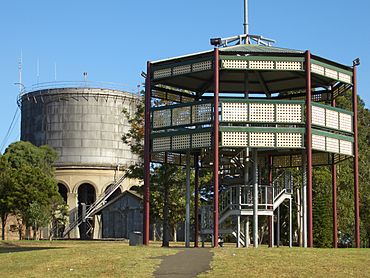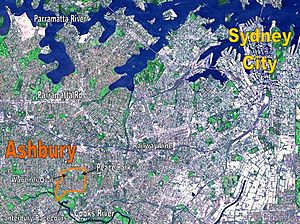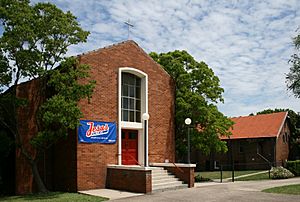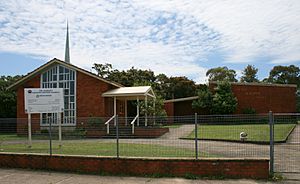Ashbury, New South Wales facts for kids
Quick facts for kids AshburySydney, New South Wales |
|||||||||||||||
|---|---|---|---|---|---|---|---|---|---|---|---|---|---|---|---|

Peace Park
|
|||||||||||||||
| Established | 1919 | ||||||||||||||
| Postcode(s) | 2193 | ||||||||||||||
| Elevation | 37 m (121 ft) | ||||||||||||||
| Location | 9 km (6 mi) south-west of Sydney CBD | ||||||||||||||
| LGA(s) |
|
||||||||||||||
| State electorate(s) |
|
||||||||||||||
| Federal Division(s) | |||||||||||||||
|
|||||||||||||||
Ashbury is a suburb in the Inner West of Sydney, in the state of New South Wales, Australia. It lies in the local government area of City of Canterbury-Bankstown with some areas in the Inner West Council and is about 10 kilometres south-west of the Sydney central business district. The postcode is 2193, the same as neighbouring Canterbury and Hurlstone Park.
Ashbury is mostly residential and has no commercial centre, although there are a few shops on King Street. Its major landmark is Peace Park, the highest point in the Canterbury local government area. Ashbury derived its name from the two neighbouring suburbs Ashfield and Canterbury. It is near Canterbury Park Racecourse.
Contents
History
Before the British colony at Sydney, the Ashbury area was home to the Wangal and Cadigal people, clans of the Darug tribe. After pressure from colonists, the British administration began subdividing land in the area surrounding the Sydney settlement and granting it to colonists. The first land grant in the area was 100 acres (40 ha) made to Reverend Richard Johnson (1753-1827), the colony's first chaplain.
The land that extended over Ashbury was known as Canterbury Vale. When it was sold to Lieutenant William Cox in 1800, it covered 600 acres (240 ha). It was then sold to Robert Campbell (1769–1846) in 1803 when it covered 900 acres (360 ha) and then proceeded to purchase more land to Liverpool Road. The estate passed onto his son-in-law Arthur Jefferey and was eventually split up. This area then became known as Goodlet's Bush, after an early settler, John Hay Goodlet. In 1878 Goodlet had bought Canterbury House, which had been built by Arthur Jeffreys.
The South Ashfield Brickworks (later called the Ashbury Brickyard) opened in 1910 from the site of what is now Peace Park. Widescale housing development of the area began in 1919. A primary school began taking students in 1924 and in 1926 changed its name from South Ashfield to Ashbury Public School, leading to the area adopting its own identity. A non-official post office was established on King St in the same year. "Ashbury" combines the names of the two nearby towns of Ashfield and Canterbury, although Ashbury itself is also the name of several villages in the British Isles.
Early Subdivision Plans
Transport
Ashbury has no railway station but it is relatively close to both Ashfield station on the Main Suburban railway line and Canterbury station on the Bankstown railway line. Transit Systems buses serve Ashbury. The 491 Five Dock to Hurstville bus links Ashbury to both Ashfield and Canterbury stations from King Street. The 413 bus links Ashbury to both Railway Square and Campsie. Route 418 links Ashbury with Burwood, Ashfield, Hurlstone Park, Marrickville, Sydenham, Mascot and Kingsford whilst the 406 connects Ashbury with Five Dock, Ashfield and Hurlstone Park via Victoria Street and Old Canterbury Road.
Ashbury borders the Cooks River and offers excellent access for cyclists and walkers to the Cooks River Cycleway.
Schools
There are two schools in Ashbury. Ashbury Public School was built in 1928. Its catchment area includes students from southern Ashfield as well as Ashbury. St Francis Xavier's Primary School began in 1930.
Housing
The area has a consistent subdivision pattern, building form and streetscape, largely because its development occurred over a relatively short period of time. A high standard of design and residential amenity was also achieved, and housing in this area has become increasingly sought after. Ashbury consists of character filled Federation and Californian bungalows which are under heritage conservation making the suburb highly sought after.
Parks
Ashbury has a multitude of parks. These Include Lees park, Peace park and Wagner Oval which is a ground for AFL .
Heritage Conservation
Special character area
In 2000, the campaign to protect the suburb's period housing was formally joined by Canterbury Council's Labor Party. Federation, Californian Bungalow, and Art Deco style dwellings were built mainly during a period that spanned four decades, from the beginning of the Twentieth Century, into the 1940s. Californian Bungalow and Art Deco style houses are referred to as Inter-War Period Housing. The homes built during this time reflected a sentiment which embraced the Art Nouveau movement covering the period from 1890 to 1910.
Heritage Architecture
The predominant Architectural Style typifying Ashbury is "Californian Bungalow". Built in the nineteen twenties, the original allotments were occupied by single storey, single dwellings, which were designed and constructed using a variety of repeated floor plans. The architectural forms featured mostly gabled and hipped roofs, covered with unglazed red terra cotta tiles. The gables were clad in fibrous cement segmented with vertical timber strip covers. Generous verandahs and leadlight windows were also commonly featured. Timber-framed awnings with decorative timber brackets also enhanced elevations and exposed rafters, dressed-all-round, added to the character and attractiveness of the homely surrounds. External timber sills were often supported by corbelled brickwork, adding a three dimensional protrusion of the windows externally, and the opportunity for a recessed bay internally. This could be used for flower arrangements or placement of ornaments. Awning windows with high sill heights would allow for natural ventilation, weather protection, and security all at the same time. Tuckpointing on manganese or liver coloured face bricks on front elevations was featured, whilst side elevations were finished in common bricks set in lime mortar.
Federation and Inter-war Period architecture
Other architectural period styles include Federation and inter-war dwellings of the nineteen thirties. Some Federation Period dwellings included roughcast rendered gable faces and brick piers. Tulips were often incised in decorative timber fretwork, whilst elaborate floral leadlights were found on front and side elevations. Prior to listing the entire suburb for heritage conservation, many of the houses were modified and added to, with little or no consideration for either scale or style of the original architecture. Leadlight windows were designed in the Art Deco style, which is reflected in the many diverse geometric patterns, typical of the 1920s and 1930s. This manifested as a direct divergence from the floral designs of the preceding Federation Period from the first two decades of the 1900s. This artistic approach to home design was reflected in the many variations of detailed elements defining the Australian adaptation of the Californian Bungalow. Picture rails, ceilings, leadlight windows, chimneys and chimney pots, terra cotta tiles and finials were typical elements of this style. Inter-war Period dwellings were marked by the more austere hipped roofs, replacing gables, with leadlights being geometrical and without colour, and brickwork featuring inset textured, or herringbone designs. Some of the houses also included curved brick walls, and Art Deco ironwork of the Universal Style. The single storey, single dwelling streetscape has been largely retained in Ashbury. Where 1st floor additions have been allowed, under the Local Government's Development Control Plan, few have been designed to complement the original architecture.
Heritage listings
- Holden Street: Ashfield Reservoir
Demographics
According to the 2016 census, there were 3,329 residents in Ashbury. 65.8% of residents were born in Australia. The most common other countries of birth were Italy 5.8%, China 2.8% and Lebanon 2.8%. 59.4% of residents spoke only English at home. Other languages spoken at home included Italian 9.3%, Greek 8.6% and Arabic 4.8%. The most common responses for religious affiliation were Catholic 40.1%, No Religion 22.1%, Eastern Orthodox 12.5%, Anglican 8.2% and Not stated 6.9%. Christianity was the largest religious group reported (71.4% of those who answered this question).
Notable residents
The following people were either born or lived in Ashbury:
- Selina Siggins (née Anderson; 1878–1964): first woman to stand as a candidate for the Australian House of Representatives (in 1903). She lived in Ashbury from 1928 till her death in 1964.
- Rev Richard Johnson (1753-1827): first chaplain of the colony in Sydney and first landowner in Ashbury, described by Watkin Tench as "the best farmer in the country".


































